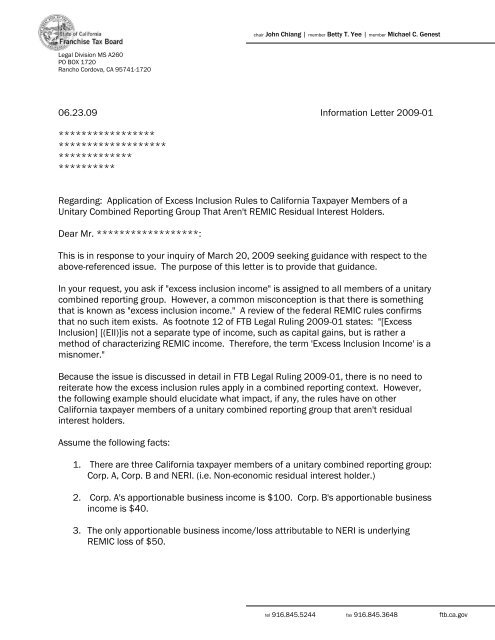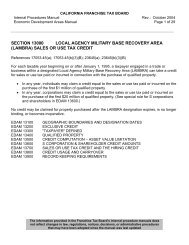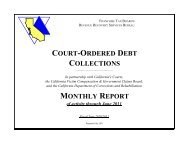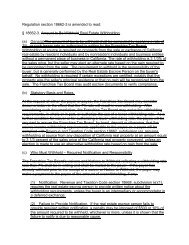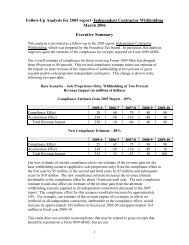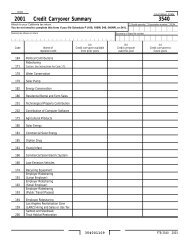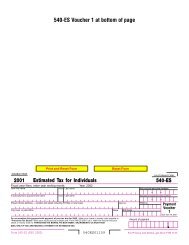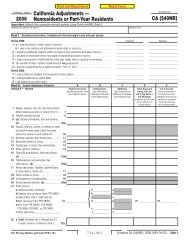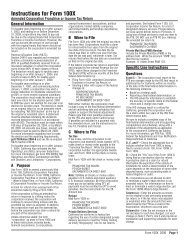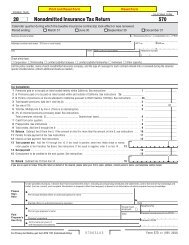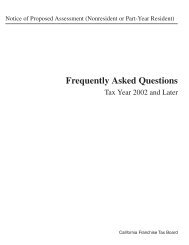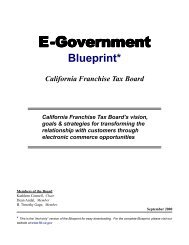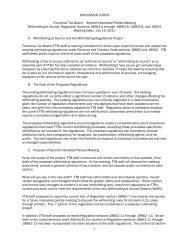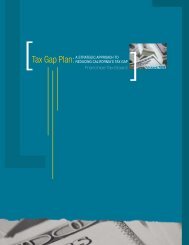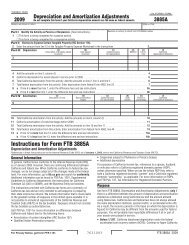Informational Letter June 23 2009 - California Franchise Tax Board
Informational Letter June 23 2009 - California Franchise Tax Board
Informational Letter June 23 2009 - California Franchise Tax Board
You also want an ePaper? Increase the reach of your titles
YUMPU automatically turns print PDFs into web optimized ePapers that Google loves.
Legal Division MS A260<br />
PO BOX 1720<br />
Rancho Cordova, CA 95741-1720<br />
chair John Chiang | member Betty T. Yee | member Michael C. Genest<br />
06.<strong>23</strong>.09 Information <strong>Letter</strong> <strong>2009</strong>-01<br />
*****************<br />
*******************<br />
*************<br />
**********<br />
Regarding: Application of Excess Inclusion Rules to <strong>California</strong> <strong>Tax</strong>payer Members of a<br />
Unitary Combined Reporting Group That Aren't REMIC Residual Interest Holders.<br />
Dear Mr. ******************:<br />
This is in response to your inquiry of March 20, <strong>2009</strong> seeking guidance with respect to the<br />
above-referenced issue. The purpose of this letter is to provide that guidance.<br />
In your request, you ask if "excess inclusion income" is assigned to all members of a unitary<br />
combined reporting group. However, a common misconception is that there is something<br />
that is known as "excess inclusion income." A review of the federal REMIC rules confirms<br />
that no such item exists. As footnote 12 of FTB Legal Ruling <strong>2009</strong>-01 states: "[Excess<br />
Inclusion] [(EII)]is not a separate type of income, such as capital gains, but is rather a<br />
method of characterizing REMIC income. Therefore, the term 'Excess Inclusion Income' is a<br />
misnomer."<br />
Because the issue is discussed in detail in FTB Legal Ruling <strong>2009</strong>-01, there is no need to<br />
reiterate how the excess inclusion rules apply in a combined reporting context. However,<br />
the following example should elucidate what impact, if any, the rules have on other<br />
<strong>California</strong> taxpayer members of a unitary combined reporting group that aren't residual<br />
interest holders.<br />
Assume the following facts:<br />
1. There are three <strong>California</strong> taxpayer members of a unitary combined reporting group:<br />
Corp. A, Corp. B and NERI. (i.e. Non-economic residual interest holder.)<br />
2. Corp. A's apportionable business income is $100. Corp. B's apportionable business<br />
income is $40.<br />
3. The only apportionable business income/loss attributable to NERI is underlying<br />
REMIC loss of $50.<br />
tel 916.845.5244 fax 916.845.3648<br />
ftb.ca.gov
06.<strong>23</strong>.09<br />
Information <strong>Letter</strong> <strong>2009</strong>-01<br />
Page 2<br />
4. Corp. A has a <strong>California</strong> apportionment factor percentage of 30%. Corp. B has a<br />
<strong>California</strong> apportionment factor percentage of 40%. NERI has a <strong>California</strong><br />
apportionment factor percentage of 10%.<br />
5. Based on the EI rules and <strong>California</strong>'s combined report rules, NERI must report a<br />
minimal amount of <strong>California</strong>-sourced income of $10.<br />
Based on these assumptions, each entity's <strong>California</strong>-sourced income is calculated as<br />
follows:<br />
Apportionable<br />
Business<br />
Income(Loss)<br />
Apportionment<br />
Factor<br />
Percentage<br />
<strong>California</strong>-<br />
Sourced Income<br />
Corp. A Corp. B NERI Total<br />
$100 $40 ($50) $90<br />
30% 40% 10% 80%<br />
$27 $36 $9 $72<br />
As the above example indicates, the $50 loss attributable to NERI from its underlying REMIC<br />
is included in the group's apportionable business income base and spread to Corp. A and<br />
Corp. B. However, even though NERI's <strong>California</strong>-sourced income would ordinarily be $9, due<br />
to the application of the EI rules, it must report $10.<br />
Assume the same facts above, except Corp. A has an apportionable business loss of $100.<br />
Apportionable<br />
Business<br />
Income(Loss)<br />
Apportionment<br />
Factor<br />
Percentage<br />
<strong>California</strong>-<br />
Sourced Loss<br />
Corp. A Corp. B NERI Total<br />
($100) $40 ($50) ($110)<br />
30% 40% 10% 80%<br />
($33) ($44) ($11) ($88)<br />
Again, the $50 loss attributable to NERI from its underlying REMIC is included in the group's<br />
apportionable business loss base and spread to Corp. A and Corp. B. However, even though<br />
NERI's <strong>California</strong>-sourced loss would ordinarily be $11, due to the application of the EI rules,<br />
it must report $10 of <strong>California</strong>-sourced income.<br />
Thereafter, Corp. A would have a NOL carryforward/carryback of $33 and Corp. B. would<br />
have a NOL carryforward/carryback of $44. However, because it must report $10 of<br />
<strong>California</strong>-sourced income, NERI will have a NOL carryforward/carryback of $21. (($11) -<br />
$10 = ($21)). (NOL carrybacks are only available for years beginning on or after January 1,<br />
2011. See <strong>California</strong> Revenue & <strong>Tax</strong>ation Code section 24416(d)(2).)
06.<strong>23</strong>.09<br />
Information <strong>Letter</strong> <strong>2009</strong>-01<br />
Page 3<br />
Please be advised that the tax law described in this information letter is considered a wellestablished<br />
interpretation or principle of tax law. This letter is provided for general<br />
information only and is not to be considered "written advice from the <strong>Board</strong>" within the<br />
meaning of Section 21012 of the Revenue and <strong>Tax</strong>ation Code.<br />
Sincerely,<br />
Craig Swieso<br />
<strong>Tax</strong> Counsel IV


